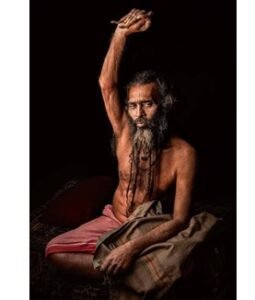The Naga Sadhus Remain A Powerful Symbol of Spiritual Resilience
Our Specialist contributor on Community and Spiritual issues, *Dr Naresh Purohit, (Member- National Disaster Relief Force), delves into the tough lives and unwavering will-power of Naga Sadhus
New Delhi/Mahakumbh: In the year 2010 when I was delivering my voluntary service as a member of the Central National Disaster Relief Force (NDRF) to the Indian soldiers braving the thunder storm along with the army doctors, stationed and based at Dras —the second coldest inhabited place  on earth after Siberia —
on earth after Siberia —
I, was awestruck to see Naga Sadhus wandering stark naked through the freezing terrain. In a place where even the most seasoned soldiers are bundled in layers of wool and fur, these ash – smeared ascetics roamed unaffected by the biting cold. For me it was a humbling experience, as it defied every survival strategy one had ever known. How could these men endure such extremes with nothing but their faith and willpower?
This extraordinary resilience stems from the “Naga Sadhus’ rigorous tapasya (austerities). Years of meditative training allow them to transcend the physical needs of the body, achieving a state of mind where neither heat nor cold holds any sway. Their practices aren’t just about endurance— they symbolize a complete surrender to divine will and a detachment from material comforts. Whether facing the icy winds of Dras or the scorching sun of the plains, the Naga Sadhus remain unwavering, a true embodiment of spiritual discipline.

Their history, too, is one of fearless commitment. In 1664, Aurangzeb’s attempt to desecrate Kashi Vishwanath Temple was thwarted by their bravery, with just 4,000 Naga Sadhus fending off 40,000 invaders. Five years later, in 1669, over 40,000 of them sacrificed their lives to protect the sacred Kashi Jyotirlinga. These stories, often omitted from textbooks, speak of a legacy forged in both spiritual devotion and martial valor.
At the Mahakumbh, their presence is more than ceremonial — it is a living reminder of their ancient mission. While some may dismiss them as relics of a bygone era, their resilience in Dras or their readiness to defend Sanatan  Dharma reminds us that their relevance transcends time.
Dharma reminds us that their relevance transcends time.
Whether inspiring awe in a remote corner of Dras or standing as fiery sentinels of faith at Prayagraj, the naga sadhus embody the indomitable spirit of Sanatan Dharma. They remind us that true strength lies not in what we possess but in what we are willing to let go of in the pursuit of higher truths.
The naga sadhus are a phenomenon that defies reason, a living testament to the mystic spirit of ancient India. With their ash-smeared bodies, fiery gazes, and mighty trishul, they evoke an otherworldly aura that bridges the past and the present. Fierce yet flamboyant, their rugged appearance transports onlookers to a realm of uncharted mysticism and ancient wisdom.

As they move through the crowds at the Mahakumbh, their trishul’s held high, the Naga sadhus exude an unrelenting determination and devotion that is as awe-inspiring as it is enigmatic. Their presence is a spectacle—an unbroken thread of India’s spiritual heritage that commands both reverence and curiosity.
To witness the Naga sadhus is to glimpse a world beyond modern conventions, a space where spiritual passion overrides physical constraints and ancient wisdom pulses with life. Whether seen as a devotee, a skeptic, or an observer, their mystique demands attention, reminding us that some phenomena transcend logic and must simply be watched, absorbed, and marveled at.
*Dr. Naresh Purohit-MD, DNB, DIH, MHA, MRCP(UK), is an Epidemiologist,  Advisor-National Communicable Disease Control Program of Govt. of India, Madhya Pradesh and several state organizations.)
Advisor-National Communicable Disease Control Program of Govt. of India, Madhya Pradesh and several state organizations.)
Dr. Purohit is also Principal Investigator for the Association of Studies For Kidney Care.
Discover more from News On Radar India
Subscribe to get the latest posts sent to your email.

Comments are closed.